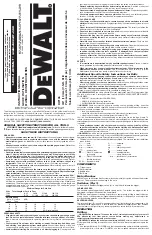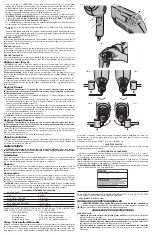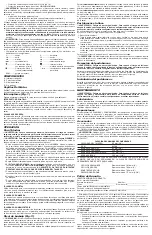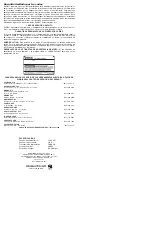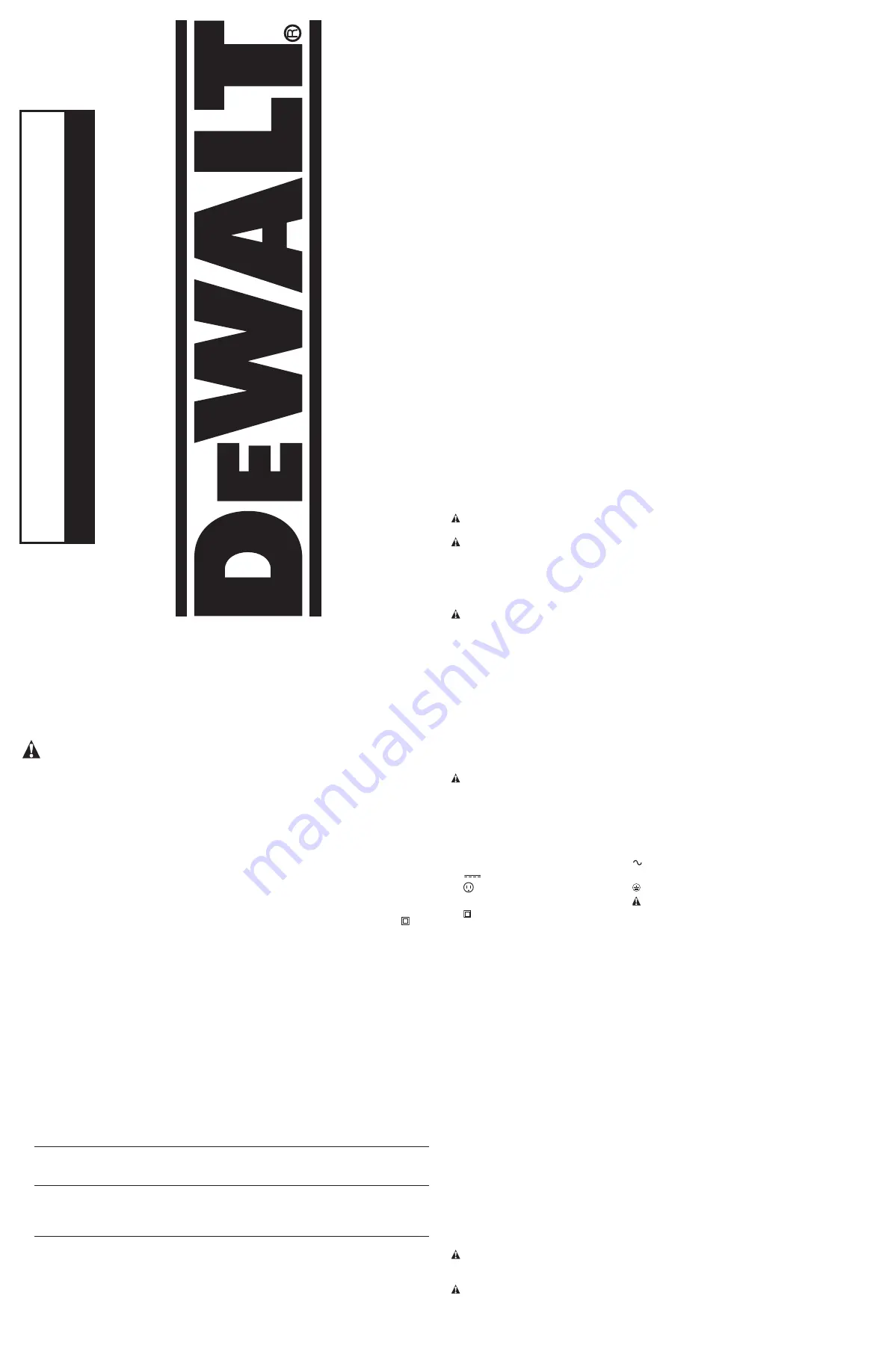
INSTRUCTION MANUAL
GUIDE D'UTILISA
TION
MANUAL
DE INSTRUCCIONES
DW106
3/8" (10 mm) V
.S.R. Drill
Perceuse de 10
mm (3/8
po) à régulateur de vitesse et inverseur de marche
T
a
ladro de 10mm (3/8") V
.V
.R.
INSTRUCTIVO DE OPERACIÓN, CENTROS DE SER
VICIO
Y
PÓLIZA
DE GARANTÍA.
ADVERTENCIA:
LÉASE ESTE INSTRUCTIVO
ANTES
DE USAR EL
PRODUCT
O.
IF YOU HAVE ANY QUESTIONS OR COMMENTS ABOUT THIS OR ANY D
E
WALT TOOL,
CALL US TOLL FREE AT:
1-800-4-D
E
WALT (1-800-433-9258)
GENERAL SAFETY INSTRUCTIONS FOR ALL TOOLS
WARNING! Read and understand all instructions.
Failure to follow all instruc-
tions listed below may result in electric shock, fire and/or serious personal injury.
SAVE THESE INSTRUCTIONS
WORK AREA
•
Keep your work area clean and well lit
. Cluttered benches and dark areas invite accidents.
•
Do not operate power tools in explosive atmospheres, such as in the presence of flam-
mable liquids, gases, or dust.
Power tools create sparks which may ignite the dust or
fumes.
•
Keep bystanders, children, and visitors away while operating a power tool.
Distractions
can cause you to lose control.
ELECTRICAL SAFETY
•
Double insulated tools are equipped with a polarized plug (one blade is wider than the
other.) This plug will fit in a polarized outlet only one way. If the plug does not fit fully
in the outlet, reverse the plug. If it still does not fit, contact a qualified electrician to
install a polarized outlet. Do not change the plug in any way.
Double insulation
elim-
inates the need for the three wire grounded power cord and grounded power supply system.
•
Avoid body contact with grounded surfaces such as pipes, radiators, ranges and
refrigerators.
There is an increased risk of electric shock if your body is grounded.
•
Don’t expose power tools to rain or wet conditions.
Water entering a power tool will
increase the risk of electric shock.
•
Do not abuse the cord. Never use the cord to carry the tools or pull the plug from an
outlet. Keep cord away from heat, oil, sharp edges or moving parts. Replace damaged
cords immediately.
Damaged cords increase the risk of electric shock.
•
When operating a power tool outside, use an outdoor extension cord marked “W-A”
or “W.”
These cords are rated for outdoor use and reduce the risk of electric shock. When
using an extension cord, be sure to use one heavy enough to carry the current your product
will draw. An undersized cord will cause a drop in line voltage resulting in loss of power and
overheating. The following table shows the correct size to use depending on cord length and
nameplate ampere rating. If in doubt, use the next heavier gauge. The smaller the gauge
number, the heavier the cord.
Minimum Gauge for Cord Sets
Volts
Total Length of Cord in Feet
120V
0-25
26-50
51-100
101-150
240V
0-50
51-100
101-200
201-300
Ampere Rating
More Not
more
AWG
Than
Than
0
-
6
18
16
16
14
6
-
10
18
16
14
12
10
-
12
16
16
14
12
12
-
16
14
12 Not Recommended
PERSONAL SAFETY
•
Stay alert, watch what you are doing and use common sense when operating a power
tool. Do not use tool while tired or under the influence of drugs, alcohol, or medica-
tion.
A moment of inattention while operating power tools may result in serious personal
injury,
•
Dress properly. Do not wear loose clothing or jewelry. Contain long hair. Keep your
hair, clothing , and gloves away from moving parts.
Loose clothes, jewelry, or long hair
can be caught in moving parts. Air vents often cover moving parts and should also be avoided.
•
Avoid accidental starting. Be sure switch is off before plugging in.
Carrying tools with
your finger on the switch or plugging in tools that have the switch on invites accidents.
•
Remove adjusting keys or wrenches before turning the tool on.
A wrench or a key that
is left attached to a rotating part of the tool may result in personal injury.
•
Do not overreach. Keep proper footing and balance at all times.
Proper footing and bal-
ance enables better control of the tool in unexpected situations.
•
Use safety equipment. Always wear eye protection.
Dust mask, non-skid safety shoes,
hard hat, or hearing protection must be used for appropriate conditions.
TOOL USE AND CARE
•
Use clamps or other practical way to secure and support the workpiece to a stable
platform.
Holding the work by hand or against your body is unstable and may lead to loss of
control.
•
Do not force tool. Use the correct tool for your application.
The correct tool will do the
job better and safer at the rate for which it is designed.
•
Do not use tool if switch does not turn it on or off.
Any tool that cannot be controlled with
the switch is dangerous and must be repaired.
•
Disconnect the plug from the power source before making any adjustments, changing
accessories, or storing the tool.
Such preventative safety measures reduce the risk of starting
the tool accidentally.
•
Store idle tools out of reach of children and other untrained persons.
Tools are dan-
gerous in the hands of untrained users.
•
Maintain tools with care. Keep cutting tools sharp and clean.
Properly maintained tools,
with sharp cutting edges are less likely to bind and are easier to control.
•
Check for misalignment or binding of moving parts, breakage of parts, and any other
condition that may affect the tools operation. If damaged, have the tool serviced
before using
. Many accidents are caused by poorly maintained tools.
•
Use only accessories that are recommended by the manufacturer for your model.
Accessories that may be suitable for one tool, may become hazardous when used on anoth-
er tool.
SERVICE
•
Tool service must be performed only by qualified repair personnel.
Service or mainte-
nance performed by unqualified personnel could result in a risk of injury.
•
When servicing a tool, use only identical replacement parts. Follow instructions in the
Maintenance section of this manual
. Use of unauthorized parts or failure to follow
Maintenance Instructions may create a risk of electric shock or injury.
Additional Specific Safety Instructions for Drills
•
Hold tool by insulated gripping surfaces when performing an operation where the cut-
ting tools may contact hidden wiring or its own cord.
Contact with a “live” wire will make
exposed metal parts of the tool “live” and shock the operator.
•
Wear safety goggles or other eye protection.
Hammering and drilling operations cause
chips to fly. Flying particles can cause permanent eye damage.
•
Keep handles dry, clean, and free from oil and grease.
This will enable better control of the tool.
CAUTION: Wear appropriate hearing protection during use.
Under some conditions and
duration of use, noise from this product may contribute to hearing loss.
WARNING: ALWAYS
use safety glasses. Everyday eyeglasses are NOT safety glasses. Also
use face or dust mask if cutting operation is dusty. ALWAYS WEAR CERTIFIED SAFETY
EQUIPMENT:
• ANSI Z87.1 eye protection (CAN/CSA Z94.3)
• ANSI S12.6 (S3.19) hearing protection
• NIOSH/OSHA/MSHA respiratory protection.
WARNING
: Some dust created by power sanding, sawing, grinding, drilling, and other
construction activities contains chemicals known to cause cancer, birth defects or other repro-
ductive harm. Some examples of these chemicals are:
• lead from lead-based paints,
• crystalline silica from bricks and cement and other masonry products, and
• arsenic and chromium from chemically-treated lumber (CCA).
Your risk from these exposures varies, depending on how often you do this type of work. To
reduce your exposure to these chemicals: work in a well ventilated area, and work with approved
safety equipment, such as those dust masks that are specially designed to filter out microscop-
ic particles.
•
Avoid prolonged contact with dust from power sanding, sawing, grinding, drilling,
and other construction activities. Wear protective clothing and wash exposed areas
with soap and water.
Allowing dust to get into your mouth, eyes, or lay on the skin may pro-
mote absorption of harmful chemicals.
WARNING:
Use of this tool can generate and/or disburse dust, which may cause serious and
permanent respiratory or other injury. Always use NIOSH/OSHA approved respiratory protection
appropriate for the dust exposure. Direct particles away from face and body.
•
The label on your tool may include the following symbols. The symbols and their definitions
are as follows:
V ............volts
A................amperes
Hz ..........hertz
W ..............watts
min..........minutes
............alternating current
........direct current
no ..............no load speed
............Class I Construction
..............earthing terminal
................
(grounded)
..............safety alert symbol
............Class II Construction
…/min........revolutions or reciprocation
................
(double insulated)
..................
per minute
BPM........beats per minute
COMPONENTS
A. Trigger switch
B. Reversing lever
C. Bubble level
D. Bull’s-eye
Motor Brushes
D
E
WALT uses an advanced brush system which automatically stops the drill when the brushes
wear out. This prevents serious damage to the motor.
Switches (Fig. 1)
To start the drill, depress the trigger switch (A); to stop the drill, release the trigger.
VARIABLE SPEED
The variable speed trigger switch permits speed control. The farther the trigger switch is
depressed, the higher the speed of the hammerdrill.
NOTE:
Use lower speeds for starting holes without a center punch, drilling in metal or plastics,
driving screws or drilling ceramics. Higher speeds are better for drilling wood and composition
boards and using abrasive and polishing accessories.
REVERSING LEVER
The reversing lever (B) is used for withdrawing bits from tight holes and removing screws. It is
located above the trigger switch. To reverse the motor, release the trigger switch FIRST and then
push the lever to the right. After any reversing operations, return lever to forward position.
OPERATION
Drilling
WARNING: Shock Hazard. To reduce the risk of serious personal injury, turn tool off
and disconnect tool from power source before making any adjustments or
removing/installing attachments or accessories.
WARNING: To reduce the risk of personal injury, ALWAYS
ensure workpiece is anchored
or clamped firmly. If drilling thin material, use a wood “back-up” block to prevent damage to the
material.
1. Use sharp drill bits only. For WOOD, use the low speed setting and twist drill bits, spade bits,
power auger bits, or hole saws. For METAL, use the low speed setting and steel twist drill
D
E
WALT Industrial Tool Co., 701 East Joppa Road, Baltimore, MD 21286
(AUG06) Form No. 638906-00 DW106 Copyright © 2006 D
E
WALT
The following are trademarks for one or more D
E
WALT power tools: the yellow and black color
scheme; the “D” shaped air intake grill; the array of pyramids on the handgrip; the kit box
configuration; and the array of lozenge-shaped humps on the surface of the tool.
If you have questions or comments, contact us.
Pour toute question ou tout commentaire, nous contacter
.
Si tiene dudas o comentarios, contáctenos.
1-800-4-D
E
W
A
L
T
• www
.dewalt.com

